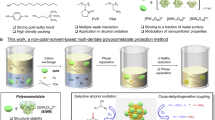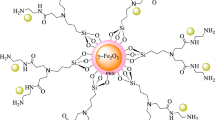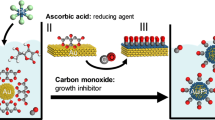Abstract
A continuing goal in catalysis is to unite the advantages of homogeneous and heterogeneous catalytic processes. To this end, nanoparticles represent a new frontier in heterogeneous catalysis, where this unification can also be supplemented by the ability to obtain new or divergent reactivity and selectivity. We report a novel method for applying heterogeneous catalysts to known homogeneous catalytic reactions through the design and synthesis of electrophilic platinum nanoparticles. These nanoparticles are selectively oxidized by the hypervalent iodine species PhICl2, and catalyse a range of π-bond activation reactions previously only catalysed through homogeneous processes. Multiple experimental methods are used to unambiguously verify the heterogeneity of the catalytic process. The discovery of treatments for nanoparticles that induce the desired homogeneous catalytic activity should lead to the further development of reactions previously inaccessible in heterogeneous catalysis. Furthermore, a size and capping agent study revealed that Pt PAMAM dendrimer-capped nanoparticles demonstrate superior activity and recyclability compared with larger, polymer-capped analogues.
This is a preview of subscription content, access via your institution
Access options
Subscribe to this journal
Receive 12 print issues and online access
$259.00 per year
only $21.58 per issue
Buy this article
- Purchase on Springer Link
- Instant access to full article PDF
Prices may be subject to local taxes which are calculated during checkout






Similar content being viewed by others
References
Zaera, F. & Joyner, R. W. (eds) The 13th International Symposium on Relations Between Homogeneous and Heterogeneous Catalysis. Top. Catal. 48 (2008).
Durán Pachón, L. & Rothenberg, G. Transition-metal nanoparticles: synthesis, stability and the leaching issue. Appl. Organometal. Chem. 22, 288–299 (2008).
Astruc, D., Lu, F. & Ruiz Aranzaes, J. R. Nanoparticles as recyclable catalysts. The frontier between homogeneous and heterogeneous catalysis. Angew. Chem. Int. Ed. 44, 7852–7872 (2005).
de Jesús, E. & Flores, J. C. Dendrimers: Solutions for catalyst separation and recycling. Ind. Eng. Chem. Res. 47, 7968–7981 (2008).
Kuhn, J. N., Huang, W., Tsung, C.-K., Zhang, Y. & Somorjai, G. A. Structure sensitivity of carbon-nitrogen ring opening: Impact of platinum particle size from below 1 to 5 nm upon pyrrole hydrogenation product selectivity over monodisperse platinum nanoparticles loaded onto mesoporous silica. J. Am. Chem. Soc. 130, 14026–14027 (2008).
Bhattacharjee, S., Dotzauer, D. M. & Bruening, M. L. Selectivity as a function of nanoparticle size in the catalytic hydrogenation of unsaturated alcohols. J. Am. Chem. Soc. 131, 3601–3610 (2009).
Lee, I., Delbecq, F., Morales, R., Albiter, M. A. & Zaera, F. Tuning selectivity in catalysis by controlling particle shape. Nature Mater. 8, 132–138 (2009).
Tian, N., Zhou, Z.-Y., Sun, S.-G., Ding, Y. & Wang, Z. L. Synthesis of tetrahexahedral platinum nanocrystals with high-index facets and high electro-oxidation activity. Science 316, 732–735 (2007).
Mahmoud, M. A., Tabor, C. E., El-Sayed, M. A., Ding, Y. & Wang, Z. L. A new catalytically active colloidal platinum nanocatalyst: the multiarmed nanostar single crystal. J. Am. Chem. Soc. 130, 4590–4591 (2008).
Narayanan, R. & El-Sayed, M. A. Shape-dependent catalytic activity of platinum nanoparticles in colloidal solution. Nano Lett. 4, 1343–1348 (2004).
Lee, H. et al. Morphological control of catalytically active platinum nanocrystals. Angew. Chem. Int. Ed. 45, 7824–7828 (2006).
Rioux, R. M. et al. Monodisperse platinum nanoparticles of well-defined shape: synthesis, characterization, catalytic properties and future prospects. Top. Catal. 39, 167–174 (2006).
Tsung, C.-K. et al. Sub-10 nm platinum nanocrystals with size and shape control: catalytic study for ethylene and pyrrole hydrogenation. J. Am. Chem. Soc. 131, 5816–5822 (2009).
Delbecq, F. & Zaera, F. Origin of the selectivity for trans-to-cis isomerization in 2-butene on pt(111) single crystal surfaces. J. Am. Chem. Soc. 130, 14924–14925 (2008).
Scott, R. W. J., Wilson, O. M. & Crooks R. M. Synthesis, characterization, and applications of dendrimer-encapsulated nanoparticles. J. Phys. Chem. B 109, 692–704 (2005).
Narayanan, R., Tabor, C. & El-Sayed, M. A. Can the observed changes in the size or shape of a colloidal nanocatalyst reveal the nanocatalysis mechanism type: homogeneous or heterogeneous? Top. Catal. 48, 60–74 (2008).
Bernechea, M., de Jesús, E., López-Mardomingo, C. & Terreros, P. Dendrimer-encapsulated Pd nanoparticles versus palladium acetate as catalytic precursors in the stille reaction in water. Inorg. Chem. 48, 4491–4496 (2007).
Zhang, X. & Corma, A. Supported gold(iii) catalysts for highly efficient three-component coupling reactions. Angew. Chem. Int. Ed. 47, 4359–4361 (2008).
Han, J., Liu, Y. & Guo, R. Facile synthesis of highly stable gold nanoparticles and their unexpected excellent catalytic activity for Suzuki-Miyaura cross-coupling reaction in water. J. Am. Chem. Soc. 131, 2060–2061 (2009).
Li, Y., Hong, X. M., Collard, D. M. & El-Sayed, M. A. Suzuki cross-coupling reactions catalyzed by palladium nanoparticles in aqueous solution. Org. Lett. 2, 2385–2388 (2000).
Djakovitch, L., Köhler, K. & de Vries, J. G. The role of palladium nanoparticles as catalysts for carbon–carbon coupling reactions in Nanoparticles and Catalysis (ed. Astruc, D.) Ch. 10, 303–348 (Wiley-VCH, 2008).
Moreno-Maas, M. & Pleixats, R. Formation of carbon-carbon bonds under catalysis by transition-metal nanoparticles. Acc. Chem. Res. 36, 638–643 (2003).
Durand, J., Teuma, E. & Gomez, M. An overview of palladium nanocatalysts: surface and molecular reactivity. Eur. J. Inorg. Chem. 23, 3577–3586 (2008).
Astruc, D. Palladium nanoparticles as efficient green homogeneous and heterogeneous carbon-carbon coupling precatalysts: a unifying view. Inorg. Chem. 46, 1884–1894 (2007).
Thathagar, M. B., ten Elshof, J. E. & Rothenberg, G. Pd nanoclusters in C–C coupling reactions: proof of leaching. Angew. Chem. Int. Ed. 45, 2886–2890 (2006).
Crooks, R. M., Mingqi, Z., Sun, L., Checkhik, V. & Yeung, L. K. Dendrimer-encapsulated metal nanoparticles: synthesis, characterization, and applications to catalysis. Acc. Chem. Res. 34, 181–190 (2001).
Rioux, R. M., Song, H., Hoefelmeyer, J. D., Yang, P. & Somorjai, G. A. High-surface-area catalyst design: synthesis, characterization, and reaction studies of platinum nanoparticles in mesoporous SBA-15 silica. J. Phys. Chem. B 109, 2192–2202 (2005).
Huang, W. et al. Dendrimer templated synthesis of one nanometer Rh and Pt particles supported on mesoporous silica: catalytic activity for ethylene and pyrrole hydrogenation. Nano Lett. 8, 2027–2034 (2008).
Fürstner, A. & Davies, P. W. Heterocycles by PtCl2-catalyzed intramolecular carboalkoxylation or carboamination of alkynes. J. Am. Chem. Soc. 127, 15024–15025 (2005).
Knecht, M. R. et al. Synthesis and characterization of Pt dendrimer-encapsulated nanoparticles: effect of the template on nanoparticle formation. Chem. Mater. 20, 5218–5228 (2008).
Ozturk, O. et al. Thermal decomposition of generation-4 polyamidoamine dendrimer films: decomposition catalyzed by dendrimer-encapsulated Pt particles. Langmuir 21, 3998–4006 (2005).
Ye, H., Scott, R. W. J. & Crooks, R. M. Synthesis, characterization, and surface immobilization of platinum and palladium nanoparticles encapsulated within amine-terminated poly(amidoamine) dendrimers. Langmuir 20, 2915–2920 (2004).
Doná, E. et al. Halogen-induced corrosion of platinum. J. Am. Chem. Soc. 131, 2827–2829 (2009).
Whitfield, S. R. & Sanford, M. S. Reactivity of Pd(ii) complexes with electrophilic chlorinating reagents: isolation of Pd(iv) products and observation of C–Cl bond-forming reductive elimination. J. Am. Chem. Soc. 129, 15142–15143 (2007).
Li, Y. & El-Sayed, M. A. The effect of stabilizers on the catalytic activity and stability of Pd colloidal nanoparticles in the Suzuki reactions in aqueous solution. J. Phys. Chem. B 105, 8938–8943 (2001).
Deutsch, D. S. et al. FT-IR investigation of the thermal decomposition of poly(amidoamine) dendrimers and dendrimer-metal nanocomposites supported on Al2O3 and ZrO2 . J. Phys. Chem. C 111, 4246–4255 (2007).
Lang, H., May, R. A., Iversen, B. L. & Chandler, B. D. Dendrimer-encapsulated nanoparticle precursors to supported platinum catalysts. J. Am. Chem. Soc. 125, 14832–14836 (2003).
Cai, W., Zhong, H. & Zhang, L. Optical measurements of oxidation behavior of silver nanometer particle within pores of silica host. J. Appl. Phys. 83, 1705–1710 (1998).
Brandes, E. A. (ed.) Smithells Metal Reference Book 6th edn (Butterworths, 1983).
Bond, G. C. Supported metal catalysts: Some unsolved problems. Chem. Soc. Rev. 20, 441–475 (1991).
LaLonde, R. L., Sherry, B. D., Kang, E. J. & Toste, F. D. Gold(i)-catalyzed enantioselective intramolecular hydroamination of allenes. J. Am. Chem. Soc. 129, 2452–2453 (2007).
Barluenga, J., Trincado, M., Rubio, E. & González, J. M. IPy2BF4-promoted intramolecular addition of masked and unmasked anilines to alkynes: direct assembly of 3-iodoindole cores. Angew. Chem. Int. Ed. 42, 2406–2409 (2003).
Fürstner, A. & Mamane, V. Flexible synthesis of phenanthrenes by a PtCl2-catalyzed cycloisomerization reaction. J. Org. Chem. 67, 6264–6267 (2002).
Nakamura, I., Sato, Y. & Terada, M. Platinum-catalyzed dehydroalkoxylation-cyclization cascade via N–O bond cleavage. J. Am. Chem. Soc. 131, 4198–4199 (2009).
Davies, I. W., Matty, L., Hughes, D. L. & Reider, P. J. Are heterogeneous catalysts precursors to homogeneous catalysts? J. Am. Chem. Soc. 123, 10139–10140 (2001).
Dahan, A. & Portnoy, M. Pd catalysis on dendronized solid support: generation effects and the influence of the backbone structure. J. Am. Chem. Soc. 129, 5860–5869 (2007).
Acknowledgements
We acknowledge support from the Director, Office of Science, Office of Basic Energy Sciences, Division of Chemical Sciences, Geological and Biosciences of the US DOE under Contract DE-AC02-05CH11231.
Author information
Authors and Affiliations
Contributions
C.A.W, W.H., C.-K.T. and J.N.K. performed the experiments and synthesized materials, substrates and catalysts. F.D.T. and G.A.S. supervised the research. All authors contributed to the conception of the experiments, discussed the results and commented on the manuscript.
Corresponding authors
Ethics declarations
Competing interests
The authors declare no competing financial interests.
Supplementary information
Supplementary information
Supplementary information (PDF 1003 kb)
Rights and permissions
About this article
Cite this article
Witham, C., Huang, W., Tsung, CK. et al. Converting homogeneous to heterogeneous in electrophilic catalysis using monodisperse metal nanoparticles. Nature Chem 2, 36–41 (2010). https://doi.org/10.1038/nchem.468
Received:
Accepted:
Published:
Issue Date:
DOI: https://doi.org/10.1038/nchem.468
This article is cited by
-
Direct C(sp2)–H Borylation of Arenes Using Ir-bpy Porous Organic Polymers
Topics in Catalysis (2023)
-
Montmorillonite clay-based heterogenous catalyst for the synthesis of nitrogen heterocycle organic moieties: a review
Molecular Diversity (2022)
-
MoS2 nanosheets/silver nanoparticles anchored onto textile fabric as “dip catalyst” for synergistic p-nitrophenol hydrogenation
Environmental Science and Pollution Research (2021)
-
PtAu bimetallic nanocatalyst for selective hydrogenation of alkenes over aryl halides
Nano Research (2019)
-
Facile synthesis of hollow structured mesoporous silica nanoreactors with confined ultra-small Pd NPs for efficient hydrogenation reactions
Journal of Porous Materials (2019)



